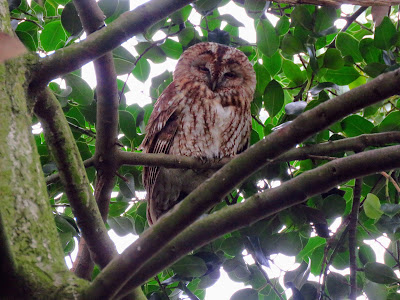 A large owl, hard to spot due to its nocturnal habits and cryptic plumage. Large, round head, and short tail gives a very compact impression. There are two colour morphs, reddish-brown (rufous) and grey, both marked with a similar pattern of paler blotches and cross-barred darker streaks, making it very cryptic when it roosts. Black eyes. It is mostly detected through its familiar hooting call, in late winter and autumn, the male's territorial call, to which female sometime replies with a loud 'ke-wick!' It has other shorted hoots and a bubbling call used when inside the nest. Occasionally calls during the day. Its presence can also be noted by birds (e.g. blackbirds) noisily mobbing ivy-covered tree. It hunts at night, mainly feeding on rodents such as mice, young rats, and voles and also moles, rabbits, frogs, birds and earthworms. It is the most urban of the UK owls, breeding in wooded areas, parks and large gardens.
A large owl, hard to spot due to its nocturnal habits and cryptic plumage. Large, round head, and short tail gives a very compact impression. There are two colour morphs, reddish-brown (rufous) and grey, both marked with a similar pattern of paler blotches and cross-barred darker streaks, making it very cryptic when it roosts. Black eyes. It is mostly detected through its familiar hooting call, in late winter and autumn, the male's territorial call, to which female sometime replies with a loud 'ke-wick!' It has other shorted hoots and a bubbling call used when inside the nest. Occasionally calls during the day. Its presence can also be noted by birds (e.g. blackbirds) noisily mobbing ivy-covered tree. It hunts at night, mainly feeding on rodents such as mice, young rats, and voles and also moles, rabbits, frogs, birds and earthworms. It is the most urban of the UK owls, breeding in wooded areas, parks and large gardens.
Status and distribution in Hull
As in the rest of the UK, the Tawny Owl is a resident breeder, probably staying in the territory year round. In Hull it has been recorded in the Avenues, Noddle Hill, Pearson Park, University Cemeteries, and plantations, but it is probably under-recorded. In 'Birds of the Hull area' breeding pairs were noted in various additional sites around Hull.
Conservation and trends
The Tawny Owl was moved from Green to Amber in 2015, due to long-term declines in numbers and range. As it is under-recorded in diurnal bird surveys, specific night surveys like the Tawny Owl survey was carried out in 2005/6 and repeated in 2018/19. The Tawny Owl survey showed a decline in occupancy from 65% to 53% in the surveyed sites between both surveys. Site occupancy was positively affected by woodland cover and an showed an adverse effect of light pollution, likely to be due to its effect on small mammal prey availability.
Conservation measures
Effective conservation measures could include:
1. Provision of nest boxes in wooded areas to supplement existing natural tree holes. Tawny Owl readily occupy nest boxes (top shot and below), suggesting that lack of natural nest sites could be limiting populations.
2. Avoid rodenticides. Rodenticides (most of them anti-coagulants) are responsible for secondary poisoning of rodent predators such as Tawny Owls, Barn Owls, Kestrels and Foxes. Rodents take several days to die and during this time they are likely to be predated. Secondary poisoning can also happen through carrion feeders eating dead rats. These chemicals accumulate in the liver and are found more often in urban raptors. Even through the level of poison might not kill the owl, it accumulates in the liver through life and might have a detrimental effect on survival or fecundity. Tawny owls are valuable for rat control, as they feed on young rats.
3. Protection for mature trees with natural holes. Dead trees, which are likely to have suitable holes, should be left standing when safe. This will also favour insects that use dead wood.
4. Secure roosting sites. Outside of the breeding season, tawny owls roost near tree branches and they favour ivy-covered trees, as they are sheltered and undisturbed during the day. Avoid the removal of ivy from trees. Ivy has many biodiversity benefits, it is a valuable source of nectar late in the year for insects, and also late berries for birds.
5. Light/noise pollution. Provision of hedgerows around green areas might acts as noise/light block
6. Reduce mowing regime in grassland will provide more seeds and aid vole and wood mouse populations (cross link to Kestrel conservation).
Further more indirect ways of helping include creating ponds to encourage insects, amphibians and birds.
Tawny owls will benefit from tree planting, as young tree plantations have longer grass that helps rodent populations.
More informationTawny Owl Point survey results.






No comments:
Post a Comment